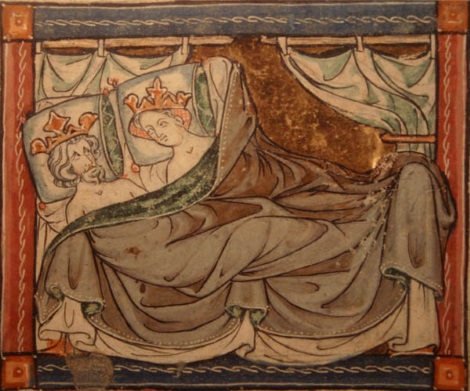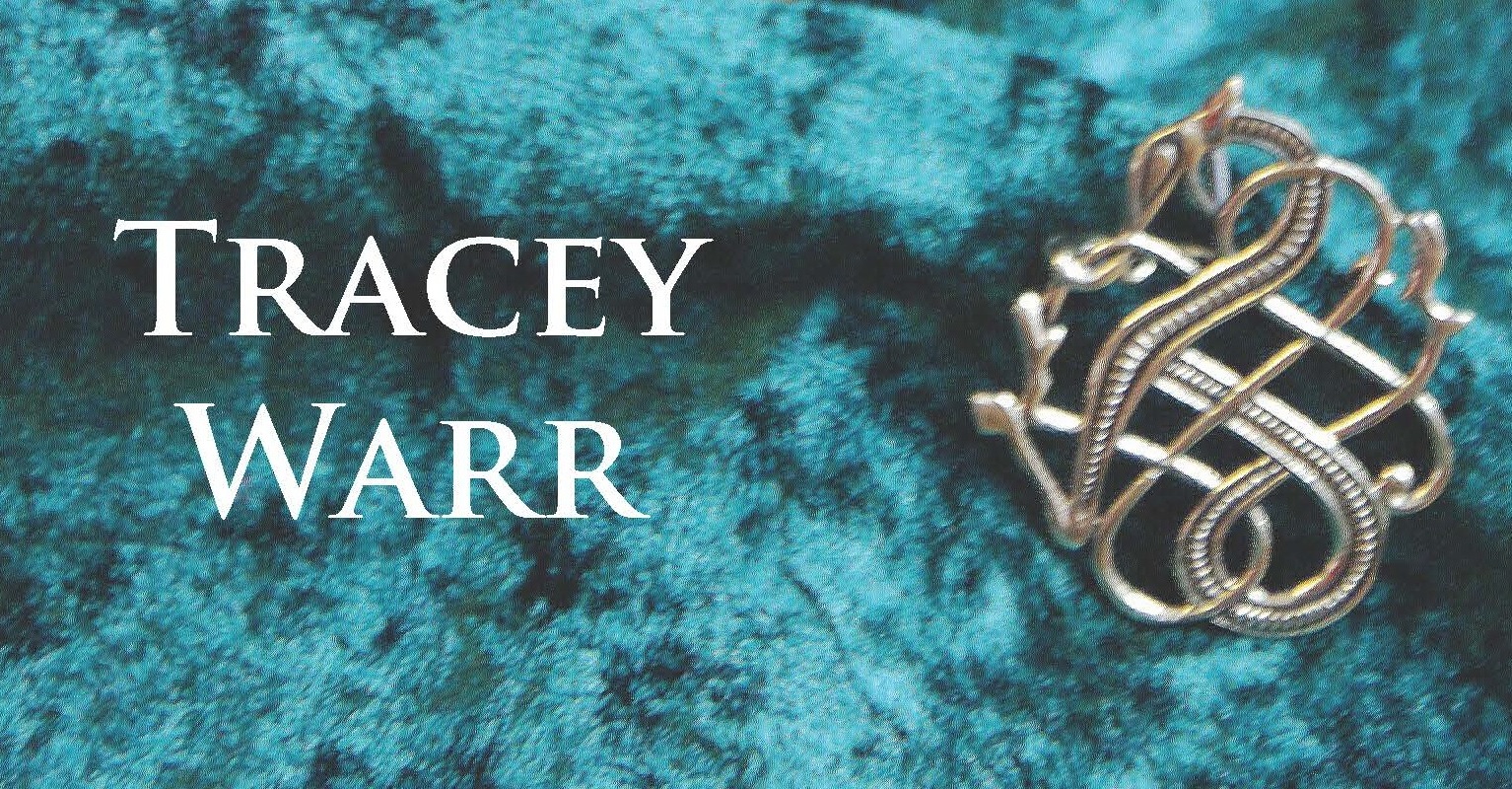
Last week I was at Carew Castle in Pembrokeshire, Wales giving a talk on the first inhabitants of the castle: Nest ferch Rhys and Gerald FitzWalter. At the front of the castle site a large, decorated stone cross bears the name of Maredudd ap Edwin, one of the 11th century rulers of the Welsh kingdom of Deheubarth. The cross and a series of ditches and ramparts discovered by archaeologists in the 1990s, indicate that Carew was an important royal fort for many centuries.

The Welsh kings were peripatetic, moving between forts, taking tribute in food and gifts, maintaining control across their territories. The fort at Carew was one of several royal sites, including Pembroke, Dinefwr and Llansteffan.
In the spring of 1093, Rhys ap Tewdwr had been king of Deheubarth for 16 years. His daughter, Nest was around eight years old. She had four brothers and her mother was pregnant with another child. There were rumours that the aggressive Norman, Bernard de Neufmarche, who had invaded lands to the north of King Rhys’s kingdom, was building a castle close to the border. The King went to investigate accompanied by his two eldest sons and his band of warriors. While the King was away, Nest, her mother, and younger brothers remained at one of the royal forts.

At first, the Normans who invaded England in 1066 left Wales more or less alone. William the Conqueror was more interested in protecting his English border against the Welsh than in trying to invade Wales. He established marcher or frontier earls at Shrewsbury, Chester and Hereford, and Robert FitzHamon established a Norman outpost at Cardiff castle. In 1081 William the Conqueror came on ‘pilgrimage’ to St Davids Cathedral on the Pembrokeshire coast. He came to see with his own eyes the state of things in Wales. Gruffudd ap Cynan had recently come from Dublin, fought a battle with other Welsh princes, and taken the kingdom of Gwynedd in the north. The Norman king, William, did not want too many strong kings in Wales. Gruffudd ap Cynan was captured by the Normans and put in prison. William the Conqueror met with King Rhys ap Tewdwr and made a peace treaty that held for 12 years.
Norman expansionism into Wales did not begin in earnest until 1087, after the death of William I and the succession of his son William Rufus, King William II. He encouraged the Norman lords to begin making inroads into Wales. William FitzBaldwin, crossed the Bristol Channel from Devon and established Rhydygors castle near Carmarthen. Bernard de Neufmarche began making inroads into the Brecknock area. A little later, Robert FitzMartin also crossed from Devon. Most of the first Norman strongholds built in Wales were simple timber and earthwork structures, motte and bailey castles.

In April 1093 Bernard de Neufmarche killed King Rhys ap Tewdwr and his eldest son, Cynan. The other son was taken prisoner and later died in prison. The Earl of Shrewsbury, Roger de Montgommery, swiftly took advantage of the power vacuum in south west Wales created by Rhys’s death. He sent his youngest son, Arnulf de Montgommery, to the important Welsh fort at Pembroke. Arnulf captured Pembroke, and also the dead King’s pregnant wife Gwladys and her daughter Nest. One of Nest’s brothers, Goronwy, was beheaded. The Normans were aiming to wipe out the royal dynasty of Deheubarth but Nest’s youngest brother, Gruffudd, a very small child, escaped the massacre and was safely hidden in Ireland, probably taken there by his uncle, Rhydderch. Queen Gwladys gave birth to another son, Hywel, who was kept in captivity in Carmarthen Castle.
We do not know what happened to Nest at this point but I have speculated in my novel that Arnulf intended to marry her and sent her to his sister, Sybil de Montgommery at Cardiff Castle to be educated. To marry a native princess was standard practice for invading Normans. It was a way of shoring up their authority in the appropriated territories. The granddaughter of the former Welsh King Gruffudd ap Llewellyn, for instance, was married to Bernard de Neufmarche.
It must have been a terrible time for Nest, ripped from her family, thrust into a Norman household where she was unable to speak French. Gradually, however, she learned the language and learned the etiquette of the Norman court such as not to turn your back on a social superior; not to sit down until a superior gave permission; not to wriggle her shoulders, or allow her hands to be touched by a man who was not her kin. Nest was now an heiress at the king’s disposal.
Arnulf de Montgommery also had lands in England, and he left the captured fort at Pembroke in the stewardship of his right-hand man, Gerald FitzWalter, who set about building new fortifications. Gerald’s orders were to hold Pembroke and expand Norman control in the surrounding lands. Gerald was a younger son of the forester of Windsor. He had no lands and titles except what he could win by his wits. The Norman hold on south west Wales at this point was precarious. The early Norman settlers were far from the Norman centres of power in England; they were vulnerable and dependent on their own resources. The Welsh, led by Cadwgan, the King of Powys, fought back successfully against the invaders. They sacked Montgommery castle, seized Carmarthen, defeated the Normans in Brecknock. William FitzBaldwin died and his followers abandoned Rhydygors castle, leaving Gerald FitzWalter as the only Norman clinging on in south west Wales. In 1095, King William Rufus conducted a military campaign into Wales but achieved little, defeated by the weather, the terrain, and the effective guerrilla tactics of the Welsh warriors.
According to his grandson, Gerald of Wales, Gerald FitzWalter was a wily, ingenious man. The first Norman castle at Pembroke was merely a stockade of wooden stakes and turfs with a small garrison. During a prolonged siege by Welsh warriors in around 1096, things were getting desperate, supplies were running short, and fifteen of Gerald’s knights deserted.

Beneath Pembroke Castle there is a rock cavern called The Wogan, which lets out into the millstream. This is probably the way the knights deserted from the besieged castle. Gerald ordered the last four pigs to be cooked and had his starving men throw some of the meat over the walls, suggesting to the Welsh besiegers that supplies were plentiful. He then put together a letter with his seal to Arnulf de Montgommery saying that he would not need reinforcements for at least four more months. Someone – perhaps Gerald himself – slipped in and out of the castle under the besiegers noses from The Wogan and left the fake letter on the ground outside the Bishop’s Palace at Lamphey, as if it had been accidentally dropped. The letter was discovered by the Welsh attackers, who believed Gerald’s ruses and called off their siege.
In 1097, King William Rufus campaigned in Wales again but yet again, he was not especially successful. Arnulf de Montgommery had perhaps petitioned the King for permission to marry Nest ferch Rhys by this time but the King stalled and did not give an answer because he was concerned about the enormous power wielded by the rebellious and arrogant Montgommery family. Nest was an important symbol of the kingdom of Deheubarth and its royal bloodline. Any man in possession of her could use her as an effective lever in his own bid for power – both in terms of her status in the eyes of the local Welsh population and in terms of the inheritance laws that the Normans adhered to. In Welsh law daughters rarely inherited, although there are a few instances of that happening, but the Normans saw girls as heiresses to lands and titles if there were no male contenders.
In 1100, King William Rufus died in a hunting accident in the New Forest and his younger brother, Henry, took the throne. Henry was an energetic and successful king who ruled for 35 years. He had many mistresses and at least 22 illegitimate children.

Nest became one of King Henry’s mistresses and bore him a son, also named Henry, who later became the lord of Narberth castle. Making Nest his mistress, was a way for the King to reduce her symbolic power for any Welsh prince or Norman noble who might try to use her to gain control of Deheubarth.

At the beginning of the 12th century, Gerald FitzWalter, began building the first Norman castle at Carew. It was a good strategic position, above the tidal estuary of the river Carew, which connected with other waterways. Rivers and coastal sea routes were the main roads of the early Middle Ages. Carew is half-way between Carmarthen and Pembroke castles, less than a day’s ride.

Gerald demolished the Welsh fort, filled in the ditches and constructed a stone tower and timber buildings within a fortified timber enclosure.
In the undercroft of the Old Tower on the ground floor, barrels full of salted and smoked food, wine and ale would have been stored. A stone tower at this time was quite an innovation and Gerald FitzWalter was clearly in touch with the latest technologies, despite being far from the Norman capital. The rectangular tower had four storeys with a first floor entrance via an exterior staircase. There was no access from the ground floor. To reach the store room in the ground floor you went down a ladder and there were also ladders up to the 2nd and 3rd floors. If the tower was attacked, the ladders could be pulled up to make things difficult for the attackers.
The powerful Montgommery family had been implicated in several rebellions and King Henry determined to deal with them. In 1102, he accused the three brothers, Robert, the Earl of Shrewsbury; Roger; and Arnulf, of treason and banished them. Arnulf holed up at Pembroke and sent Gerald FitzWalter to Ireland to negotiate on his behalf with the Irish king Muirchertach ua Briain who gave Arnulf soldiers, ships and his daughter Lafracoth in marriage. Arnulf escaped to Ireland to evade King Henry’s anger, but Gerald did not go with him. After the fall of the Montgommerys, Henry at first sought to control south Wales through Welsh allies. Gerald FitzWalter, as Arnulf’s man, could not be trusted and despite his years of valiantly defending Pembroke he was obliged to hand over that castle, and probably Carew as well, to a Norman knight named Saer who became steward for a few years. Gerald had lost everything he had fought for.
The story of Nest and Gerald continues tomorrow in Part 2.

Conquest I: Daughter of the Last King by Tracey Warr (Impress, 2016) is available now and Conquest II: The Drowned Court will be published in October.
Sources – Part 1
Austin, David, ed. (1993) Carew Castle Archaeological Project: 1992 season interim report, Lampeter: University of Wales.
Austin, David, ed. (1995) Carew Castle Archaeological Project: 1993 season interim report, Lampeter: University of Wales.
Austin, David, ed. (1995) Carew Castle Archaeological Project: 1994 season interim report, Lampeter: University of Wales.
Babcock, Robert S. (1993) ‘Rhys ap Tewdr’, Anglo-Norman Studies, 16, pp. 21-35.
Gerald of Wales (c. 1191) The Itinerary Through Wales.
Gerald of Wales (c. 1194) The Description of Wales.
Johns, Susan M. (2013) Gender, Nation and Conquest in the High Middle Ages: Nest of Deheubarth, Manchester: Manchester University Press.
Kenyon, John R. (2010) ‘Carew Cross, Castle and Mill’, Archaeologists Journal, vol. 167, supplement 1: South-west Wales: Pembrokeshire and Western Carmarthenshire.
Matthew Paris (1255) Historia Anglorum.
Maund, Kari (2007) Princess Nest of Wales: Seductress of the English, Stroud: Tempus.
Rowlands, Ifor W. (1981) ’The making of the March: Aspects of the Norman settlement in Dyfed’, Anglo-Norman Studies, 3, pp. 142-157 & 221-225.
Searle, Eleanor (1980) ‘Women and the legitimization of succession’, in Brown, R. Allen, ed. (1981) Anglo-Norman Studies III: Proceedings of the Battle Conference, pp. 159–170.
